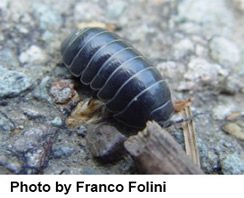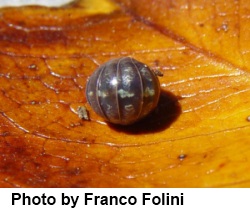Sometimes Inseparable: the Backyard Crustacean and the Bacteria
(04/26/2009)
Lift a rotting log or brick in your back yard or in a local park and there’s a good chance you’ll find tiny crustaceans. You won’t find crabs and lobster and the  usual crustaceans that live in the ocean. But what you will find in almost every environment where there is damp soil are small (1/4-1/2 inch, 0.5-1.5 cm) terrestrial crustaceans called pillbugs. usual crustaceans that live in the ocean. But what you will find in almost every environment where there is damp soil are small (1/4-1/2 inch, 0.5-1.5 cm) terrestrial crustaceans called pillbugs.
Aside from the curious discovery of crustaceans in your backyard, there is another interesting twist about the pillbugs you can find in your backyard. There is a good chance that if you knew how to check, and were so inclined, you’d find that almost all of them are female. If you had the equipment needed to check those female pillbugs, you might find that while they are fully functioning females – able to mate with a male and lay fertile eggs – they are all genetically male. And despite the fact that they are genetically male, when they mate, all of their babies are female.
That’s odd enough, but to take the weirdness one step further, if you treated your collection of female pillbugs with antibiotics, they would no longer have all female babies, they would have all male babies.
At this point, you could be forgiven for wondering what on earth is going on. The situation was equally baffling to scientists who noticed sex ratios heavily skewed towards females in some mosquitoes. Scientific detective work in the 1920s eventually identified a bacteria, now called Wolbachia pipientis, as the cause of this strange situation. But only in the last 20 years has it become apparent that Wolbachia infects many arthropods such as insects and crustaceans, and it often affects the gender ratios and reproduction of its hosts. Today, Wolbachia is a hot topic among evolutionary scientists.
In the case of pillbugs, the bacteria cancel out the function of the gland that produces male hormones. When a pillbug develops from an egg, the “default” pathway is to develop as a female. When a pillbug egg is genetically male, an androgen gland forms and begins to produce male hormones. This causes the development of the pillbug embryo to proceed along the male pathway. But if you surgically remove the androgen gland (it can be done!), or if Wolbachia bacteria disrupt the androgen gland, development defaults to female, even though the baby pillbug is genetically male.
This has a great benefit to the Wolbachia bacteria.
Wolbachia bacteria are not easily passed from one pillbug to the next (and they have never been known to infect people or other mammals). But thebacteria live very happily in egg cells. So when a Wolbachia-infected female pillbug lays eggs, she passes on the infection to each of her eggs. Because of the way sperm develop, Wolbachia can’t live in sperm cells. So the bacteria isn’t passed on by a male pillbug through sperm.
For the Wolbachia bacteria then, females are good. Males are a dead end.
Over the ages, the Wolbachia bacteria that evolved ways to change the sex of their hosts, whether crustaceans or insects, to females, were able to multiply more rapidly.
The final twist to the story is that Wolbachia infection can lead to the loss of the female sex chromosome, the very chromosome that originally determined which pillbugs are females. In high school biology, we learn that in humans, females have two X sex chromosomes, and males have an X and a Y sex chromosome. In pillbugs, however, the situation is reversed. Females have two different sex chromosomes, designated W and Z, and males have two matching Z chromosomes.
Remember that when a Wolbachia infection takes over, males develop as females. But they are still genetically male, with two Z sex chromosomes and no W chromosome. When one of these genetically male, but functionally female, pillbugs mates with a functional male, both have only male sex chromosomes. So all the babies, even though about 80% will develop as females, have only male sex chromosomes. About 20% of eggs escape infection, and they develop normally, providing the few lucky males that mate with all the females.
In any species, individual females that only have female babies will multiply much faster than females that have both male and female babies because it only takes a few males to fertilize many females. Over the course of just a few generations, females that are infected with Wolbachia will come to dominate the population and normal females will become a smaller and smaller percentage of the population and eventually disappear.
When that happens, the female chromosome can be lost from the population entirely. Then, if you treat such a population of pillbugs, all of which have only male sex chromosomes, with an antibiotic like tetracycline to kill the Wolbachia bacteria, the entire next generation of eggs will be free of Wolbachia bacteria. They will all have male sex chromosomes, since there are no female chromosomes around. But without Wolbachia to disrupt their male hormone production, the population will all develop as males – and will die out in a single generation because there are no females to lay eggs.
The odd fact is that once Wolbachia has spread throughout a population of pillbugs to the point that genetic females have been completely outcompeted, there is no going back. The pillbugs are completely dependent on Wolbachia for reproduction. No Wolbachia, no females, and therefore no baby pillbugs.
So if you lift a log in your backyard, be sure to look for the little terrestrial crustaceans. You can gently pick them up. They don’t bite or sting. If you pick up a true pillbug, it may even do its defense trick and roll up into a  tight, armored ball that will roll around in your palm like a tiny marble. tight, armored ball that will roll around in your palm like a tiny marble.
But whatever you do, don’t treat your new friends with antibiotics to save them from their Wolbachia infection. You might do more harm than good.
For more information:
Much of the scientific research on Wolbachia and its effects on pillbugs and arthropods has been done by scientists at the Universityof Poitiers in Poitiers, France. For more in-depth information on Wolbachia and pillbugs, go to: http://ecoevol.labo.univ-poitiers.fr/?lang=en. My thanks to Professor Didier Bouchon for his assistance.
|